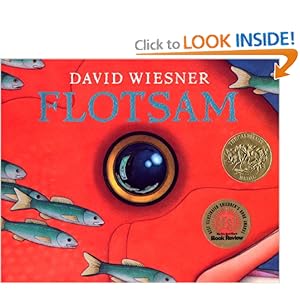Bibliography
Kellogg, Steven.1997. THE THREE LITTLE PIGS. New York: William Morrow and Company, Inc. ISBN 0-688-08732-9
Plot Summary
In this retelling of a well known tale, Serafina Sow starts her own waffle-selling business in order to enable her three children to prepare for the future. She retires and gives the business to her children, Percy, Pete, and Prudence. Life is pretty sweet for the three little pigs, until a hungry wolf named Tempesto shows up one morning. Percy, Pete, and Prudence refuse to let themselves become breakfast without a fight. This story is a refreshing change from the classic version of the three pigs story. The pigs, not only have names, but they also attend school and run the family business. Neither the pigs nor the big, bad, thug-like wolf get eaten. Instead, there is a humorous and positive ending to this tale.
Critical Analysis
With his hilarious retelling and irresistible illustrations, Steven Kellogg updates the classic folktale for a new generation of readers. Kellogg uses colored inks, watercolors, and acrylics to create full color fun and intricate illustrations.
Review Excerpts
Booklist “Just as the pig family in this story soups up their old waffle iron with four wheels and various tanks, pipes, and hoses, so Kellogg takes a favorite folk tale and adds his own inventive touches of character, plot twists, and humor. Serafina Sow supports her three little pigs with her traveling waffle business, but when the children graduate from Hog Hollow Academy, she retires to the Gulf of Pasta and turns the business over to the next generation. Percy builds a straw bungalow, Pete a log cabin, and Prudence a brick cottage. When Tempesto the wicked wolf looks at the waffle menu and orders piglet, the traditional tale is off and running, with some entirely new details and no apologies to anyone. Much of the broad humor is carried in the lively, colorful illustrations, though there's wordplay aplenty in the text and pictures too: Tempesto slides down the chimney, lands on the waffle iron, is blasted with maple syrup, smothered in butter, and turned into a "WOLFFLE." Just as Serafina's customers flock to The Wheeled Wafflery, so children will greet Kellogg's latest picture book with eagerness based on memories of his many satisfying books. Pure pleasure for Kellogg fans.”
Kirkus Reviews “Kellogg puts a master's spin on another familiar tale. These three pigs can afford to build new houses with profits reaped from their mother's mobile waffle business, which they inherit when Serafina Sow retires to the Gulf of Pasta. Tempesto, the big bad wolf (sporting a leather jacket and engineer boots), doesn't care about waffles; he sees the pigs as ham, bacon, and sausage. After devastating their straw and wood homes, he creates a hot-air balloon out of a garbage bag to descend down the chimney of the brick house. Luckily, Serafina pulls herself out of retirement just in time to stick the waffle grill under the descending wolf's bottom--a ``wolffle.'' As usual, Kellogg's illustrations add to the story; intrepid readers will have fun finding art on the wall by Pablo Pigasso, perusing the long list of waffle flavors (among them, baloney and bubblegum), and giggling at the wolf's shirt, which sports slogans, ``Say Yes to Thugs,'' and ``Thugs Need Hugs Too.''A talent-strewn retelling that only enhances the original.”
Booklist "...lively, colorful illustrations...wordplay a plenty in the text and pictures too..."
Publishers Weekly "Buoyant pictures and a pun-riddled text add gusto to Kellogg's light hearted humor..."
Connections
* Have students listen to several selections ( folktale, fiction, non-fiction, fairytale) presented orally and identify the characteristics that make each a folktale.
*Ask students to orally compare and contrast several versions of The Three Little Pigs by completing a chart on the key elements of each story.
*During Center time student could practice putting events and ideas into a logical sequence using quoted pages from the book. Also you could have students illustrate what the quoted pages are depicting.
*Have students illustrate and put story events in sequence to retell Three Little Pigs.
Images from
http://www.amazon.com/










